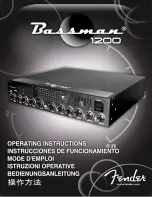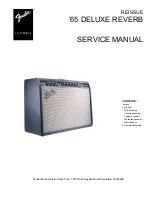
5-16
Remote Programming
The SNAP? command is a query only command. The SNAP? command
is used to record various parameters simultaneously, not to transfer data
quickly.
OAUX? i
The OAUX? command reads the Aux Input values. The parameter i
selects an Aux Input (1, 2, 3 or 4) and is required. The Aux Input voltages
are returned as ASCII strings with units of Volts. The resolution is
1/3 mV. This command is a query only command.
SPTS ?
The SPTS? command queries the number of points stored in the buffer.
Both displays have the same number of points. If the buffer is reset, then
0 is returned. Remember, SPTS? returns N where N is the number of
points - the points are numbered from 0 (oldest) to N-1 (most recent).
The SPTS? command can be sent at any time, even while storage is in
progress. This command is a query only command.
TRCA ? i, j, k
The TRCA? command queries the points stored in the Channel i buffer.
The values are returned as ASCII floating point numbers with the units of
the trace. Multiple points are separated by commas and the final point is
followed by a terminator. For example, the response with two points
might be "-1.234567e-009,+7.654321e-009,".
The parameter i selects the display buffer (i=1, 2) and is required. Points
are read from the buffer starting at bin j (j
≥
0). A total of k bins are read
(k
≥
1). To read a single point, set k=1. Both j and k are required. If j+k
exceeds the number of stored points (as returned by the SPTS? query),
then an error occurs. Remember, SPTS? returns N where N is the total
number of bins - the TRCA? command numbers the bins from 0 (oldest)
to N-1 (most recent). If data storage is set to Loop mode, make sure that
storage is paused before reading any data. This is because the points
are indexed relative to the most recent point which is continually
changing.
TRCB ? i, j, k
The TRCB? command queries the points stored in the Channel i buffer.
The values are returned as IEEE format binary floating point numbers
(with the units of the trace). There are 4 bytes per point. Multiple points
are not separated by any delimiter. The bytes can be read directly into a
floating point array (in most languages).
Do not query the IFC (no command in progress) status bit after sending
the TRCB command. This bit will not be set until the transfer is complete.
When using the GPIB interface, EOI is sent with the final byte. The points
must be read using a binary transfer (see your GPIB interface card soft-
ware manual). Make sure that the software is configured to NOT termi-
nate reading upon receipt of a CR or LF.
When using the RS232 interface, the word length must be 8 bits. The
points must be read as binary bytes (no checking for linefeeds, carriage
returns or other control characters). Most serial interface drivers are
designed for ASCII text only and will not work here. In addition, the data
transfer does not pause between bytes. The receiving interface must
always be ready to receive the next byte. In general, using binary trans-
Содержание SR830
Страница 5: ...1 4...
Страница 11: ...SR830 DSP Lock In Amplifier 1 10...
Страница 13: ...2 2 Getting Started...
Страница 17: ...2 6 The Basic Lock in...
Страница 23: ...2 12 Outputs Offsets and Expands...
Страница 25: ...2 14 Storing and Recalling Setups...
Страница 31: ...3 4 SR830 Basics...
Страница 33: ...3 6 SR830 Basics...
Страница 37: ...3 10 SR830 Basics...
Страница 53: ...3 26 SR830 Basics...
Страница 74: ......
Страница 83: ...4 30 Rear Panel...
Страница 107: ...5 24 Remote Programming...
Страница 113: ...5 30 Remote Programming...
Страница 117: ...5 34 Remote Programming...
Страница 121: ...6 4 Performance Tests...
Страница 123: ...6 6 Performance Tests...
Страница 125: ...6 8 Performance Tests...
Страница 129: ...6 12 Performance Tests...
Страница 131: ...6 14 Performance Tests...
Страница 133: ...6 16 Performance Tests...
Страница 139: ...6 22 Performance Tests...
Страница 145: ...7 2 Circuit Description...
















































